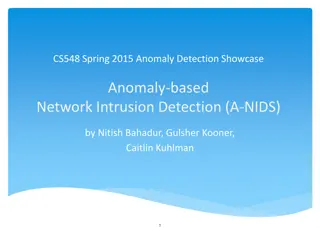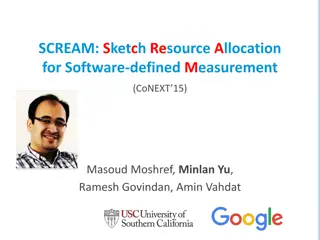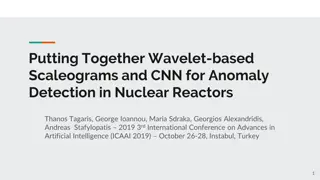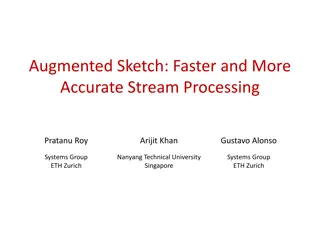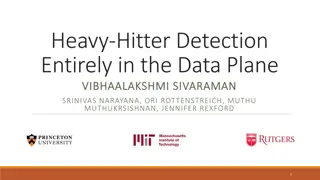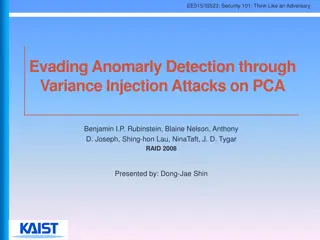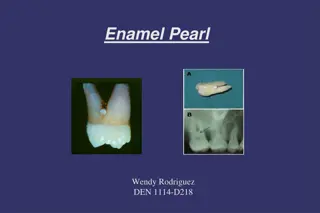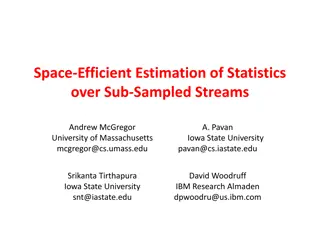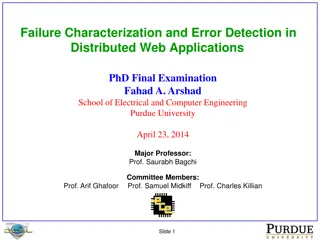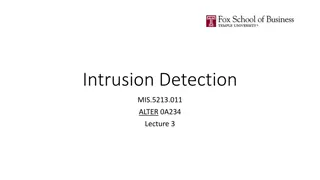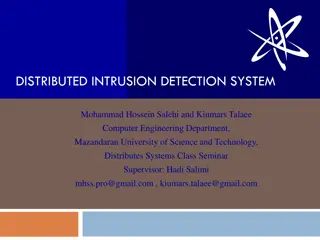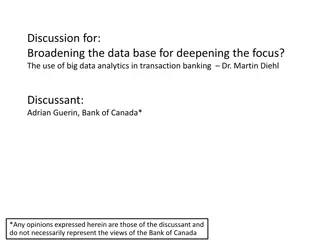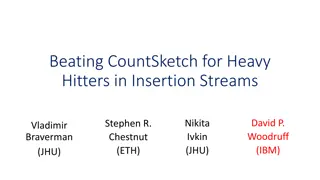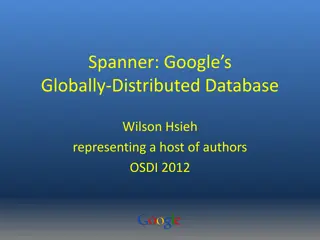LD-Sketch: Distributed Sketching Design for Anomaly Detection in Network Data Streams
LD-Sketch is a novel distributed sketching design for accurate and scalable anomaly detection in network data streams, addressing challenges such as tracking heavy keys in real-time across a vast key space. By combining high accuracy, speed, and low space complexity, LD-Sketch enables efficient heavy key detection in a distributed architecture. The work presents a solution for detecting heavy hitters and changers, enhancing both scalability and detection accuracy through experiments on real-world traces.
Download Presentation

Please find below an Image/Link to download the presentation.
The content on the website is provided AS IS for your information and personal use only. It may not be sold, licensed, or shared on other websites without obtaining consent from the author. Download presentation by click this link. If you encounter any issues during the download, it is possible that the publisher has removed the file from their server.
E N D
Presentation Transcript
LD-Sketch: A Distributed Sketching Design for Accurate and Scalable Anomaly Detection in Network Data Streams Qun Huang and Patrick P. C. Lee The Chinese University of Hong Kong, Hong Kong INFOCOM 14 1
Motivation Network traffic: a stream of (key, value) tuples Keys: src IPs, five-tuple flows Value: # of packets, payload bytes Heavy keys - classical anomalies in network traffic Heavy hitters: keys with large volume in one period e.g. SLA violation Heavy changers: keys with large volume change across two periods e.g. DoS attacks, component failures Goal: identify heavy keys in real time 2
Challenges Enormous key space e.g., 5-tuple IPv4 flows are drawn from key domain of size 2104 Per-key tracking is infeasible Line-rate processing Single machine fails to keep pace with line rate Seamless distributed detection Apply single-machine detection in distributed architecture Open issue: How to achieve both scalability and accuracy ? 3
Related Works Counter-based techniques Misra-Gries algorithm [Misra & Gries 82]; Lossy Counting [Manku et al. 02]; Space Saving [Metwally et al. 05]; Probalistic Lossy Count [Dimitropoulos et al. 08] Only address for heavy hitter detection in single machine Sketch-based techniques Multi-stage filter [Estan et al. 03]; CGT [Cormode et al. 04]; Reversible Sketch [Schweller et al. 06]; SeqHash [Tian et al. 07]; Fast Sketch [Liu et al. 12] Only work in single machine Distributed detection [Cormode et al. 2005] [Manjhi et al. 2005] [Yi et al. 2009] Only address heavy hitter detection 4
Our Work LD-Sketch: a new sketching design for heavy key detection in a distributed architecture A sketch technique for local detection High accuracy High speed Low space complexity A distributed detection scheme not only achieves scalability but also improves accuracy Experiments on real-world traces 5
Problem Formulation Perform detection in each time period (epoch) Input data: a stream (key, value) tuple (?,??) True sum ?(?): sum of values of key ? in the time period True change ?(?): absolute value of difference of ?(?) in current and last epochs Heavy hitters: all ? with ? ? ? Heavy changers: all ? with ? ? ? Problem: infeasible to track ? ? and ? ? in real-time with limited memory 6
Architecture Data source Data source Data source Data source Data source Remote site Remote site Remote site Remote site Remote site Worker Worker Worker Distributed detection Local detection Local detection Local detection Local detection results Final detection results 7
Local Detection ? buckets LD-Sketch Structure of ?rows, with ? buckets each 1 Update phase For each data item ?,?? select a bucket for row i by hashing key ? with function h?? update the bucket with the data item (?,??) Detection phase key ? 2 ? rows ? Examine the buckets and report heavy keys 8
Inside a Bucket Basic ideas Track significant keys in a bucket with array ??,? Increment length ??,? based of total sum ??,? and parameter ? Record error ??,? due to dropping insignificant keys Bucket (?,?) Expansion parameter ? Total sum: ??? 1 ????? ??? 2 ????? Array ??,? ??,? length: ??,? Error: ????? ??,? 9
Update Bucket with (?,??) Four cases Case 1: ? ??,? Update ??,? directly: ??,?? ??,?? + ?? Case 2: ? ??,? but ??,? has empty slots Insert key ? into ??,?, and set ??,?= ?? Cases 3 & 4: ? ??,?, ??,? is full ??,? ? Expansion number ? = Based on ? and ??,?: Case 3: decrement keys in ??,? Case 4: expand ??,?dynamically 10
Decrement Keys Case 3: ? + 1 ? + 2 1 ??,? Example y 5 ??,? Bucket ?,? ? = 0 ??,?= 1 ??,?= 2 Step 1 New data item (?,??) ? ? 3,?? ??= 3 5,?? ??= 5 5,?? ??= 8 ? = Procedure Step 1: calculate decrement value ? = min(??, min ? ??,???,?[?]) 11
Decrement Keys Procedure (cont.) Step 2: Update ??,? ??,?+ ? Step 3: Update ??,?: ??,?? ??,?? ?, for all y ??,? Remove all ? with ??,?? = 0 Insert key ? with ??,?? = ?? ? if ??> ? Step 2 5,?? ??= 3 7,?? ??= 5 7,?? ??= 8 ??,?= y 2 After ??= 3 Step 3 y 5 empty Before After ??= 5 x 3 After ??= 8 12
Dynamic Expansion Case 4: ? + 1 ? + 2 1 > ??,? Add ? + 1 ? + 2 1 ??,? new counters to ??,? Set ??,?= ? + 1 ? + 2 1 Insert key ? with ??,?? = ?? Before ??,? ?2 ?1 ?3 ?4 ?5 ??,?= 5 ? = 2 After ??,? ?4 ?3 ?5 ?2 ? ?1 ??,?= 11 13
Estimate True Sum or Change Estimate ?(?) in bucket (?,?): a pair of values ???? = ??,?? , if ? ??,? 0, otherwise ??? = ??,? ??,? ???? + ??,? ??,? Estimate ?(?) in bucket (?,?) Bucket (?,?) at 1st epoch Bucket (?,?) at 2nd epoch ??,2? ??,1? ???,2? and ??,? ???,1? and ??,? ??,? ??,? Estimate change: ??,2? ??,? ??,1? ??,? ???,1? ,??,? ???,2? } ??,?? = max{??,? 14
Identify Heavy Key Key point: consider keys tracked by buckets Enumerate all buckets ??,? ? ? ??,?, check key ? Bucket (?,?) Check key ? for heavy hitters ?? ? for all row ? ??, ?(?) Check key ? for heavy changers ??, ?(?)? for all row ? 15
Analysis Let maximum number of heavy keys = ? On accuracy Zero false negative rate Upper bound of false positive rate On complexity time complexity to update a data item: ?(1) time complexity to identify heavy keys: ?(?) space complexity: ?(?) 16
Distributed Detection Goal Scalability: reduce complexity Accuracy: reduce false positive rate Remote site Worker Remote Site How to partition data streams Local detection Local detection results Final results How to aggregate local detection results Final detection results 17
Remote Sites Two-step partitioning Data item (?,??) Step 1: select ? workers based on ? Worker Worker Worker Worker Worker Step 2: select one from the ? workers uniformly Worker Worker Worker For same ?, the same ? workers are selected in all remote sites 18
Detection and Aggregation Detection in workers For key ?, each selected worker expects to receive 1/? of ?(?) Perform local detection in each worker with threshold ? ? Aggregate results All ? workers report ? in the local detection For key ? Report ? as a heavy key 19
Analysis Let Maximum number of heavy keys = ? Total number of worker = ? On accuracy Reduce false positive rate Introduce a small false negative rate due to unfair partitioning On complexity time complexity to update a data item: ?(1) time complexity to identify heavy keys: ?(??/?) space complexity: ?(??/?) 20
Experimental Results Trace 3G UMTS network in mainland China in December 2010 1.1 billion packets, 600GB traffic Approach Local detection: compare LD-Sketch with CGT, SeqHash, Fast Sketch, all of which are allocated same amount of memory Distributed detection: vary the value of ? Metrics Recall: (# of returned true heavy keys) / (# of true heavy keys) Precision: (# of returned true heavy keys) / (# of return keys) Update throughput 21
Accuracy of Local Detection: Heavy Changer LD-Sketch achieves 100% recall LD-Sketch has a little lower precision than CGT and Seqhash, but we can improve with distributed detection 22
Accuracy of Distributed Detection: Heavy Changer When ? = 1, the precision is similar to local detection When ? > 1, the precision significantly increases while lose a little recall 23
Throughput Local detection Distributed detection LD-Sketch has a little lower throughput than CGT and Fast Sketch in local detection LD-Sketch can scale linearly in distributed detection 24
Conclusions Propose LD-Sketch, a sketching approach for real-time heavy key detection in a distributed architecture Composed of local detection and distributed detection Propose a sketch structure for local detection High accuracy Low complexity in space and time Seamlessly deployed in distributed architecture Propose a distributed detection scheme Reduce complexity Improve accuracy 25



